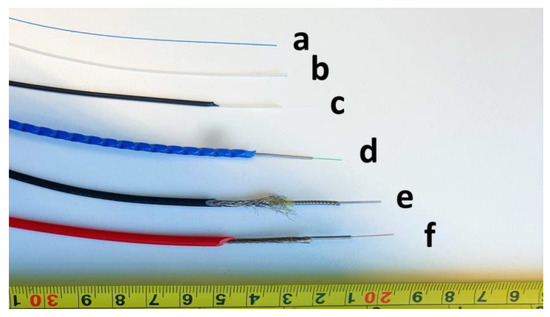Enhance Your Fibre Optic Projects With an Effective Diameter Analyser
The combination of an efficient size analyser right into fibre optic jobs serves as a pivotal element in achieving accuracy and consistency. By promoting accurate diameter measurements, these analysers not only boost the top quality of installments however likewise minimize potential compatibility concerns amongst elements.
Value of Size Dimension
Gauging the diameter of fiber optic cables is an important task that guarantees optimum efficiency and dependability in interaction systems. Exact diameter measurement is necessary for various reasons, mainly for maintaining signal stability and minimizing loss. A cable television's diameter directly affects its capability to transmit light successfully; discrepancies from the specified diameter can cause raised depletion, which affects the total efficiency of the network.
Moreover, precise measurement is vital throughout the installment and upkeep of fibre optic systems. An incorrect fit in between ports and cords can lead to signal destruction or full failure of interaction links. By guaranteeing that diameters are within defined tolerances, professionals can enhance compatibility between elements, causing better system reliability.
Furthermore, diameter measurement plays a significant duty in quality assurance throughout manufacturing. Uniformity in the size of fibre optic cables is vital for ensuring consistent performance across various batches. optical fibre diameter analyser. This uniformity assists manufacturers keep sector standards and cultivates confidence among end-users
Functions of an Effective Analyser
A reliable analyser for fiber optic tasks need to integrate a number of essential features that boost precision and usability in diameter dimension. High-resolution optical sensors are crucial for specific diameter readings, allowing individuals to spot also the slightest variations in fiber thickness. These sensors must be matched by advanced calibration systems, making certain consistent efficiency across different conditions and materials.
Second of all, an easy to use user interface is critical for promoting convenience of procedure. This includes intuitive software program that permits seamless data input and output, along with visual representations of the measurements taken. A portable design boosts usability in numerous area environments, making it easier to perform assessments on-site.
In addition, the analyser needs to sustain multiple measurement settings, accommodating different fiber kinds and applications. The capability to store and fetch historical data is another vital attribute, allowing customers to track performance over time and make notified decisions.
Advantages for Fibre Optic Projects
Executing a size analyser in fiber optic jobs provides considerable advantages that considerably enhance project efficiency and quality. Among the key advantages is the capacity to ensure specific dimensions of fibre size, which is important for preserving optimal performance in fibre optic systems. Accurate diameter readings aid in the recognition of variances that might result in signal destruction or loss, hence making certain top quality transmission.
Furthermore, using a diameter analyser simplifies the top quality control procedure. By automating dimension tasks, job groups can decrease the moment invested on hands-on examinations, causing faster project completion and decreased work costs. This effectiveness likewise enables more strenuous screening protocols, leading to enhanced product integrity.
Additionally, consistency in fibre size dimensions advertises compatibility with various other fiber optic components, lessening the threat of installation mistakes and boosting total system efficiency. The unification of a size analyser not only aids in preserving market requirements yet also fosters self-confidence in project deliverables.
Assimilation Into Existing Workflows
Incorporating a diameter analyser right into existing workflows can substantially enhance the functional performance of fiber optic tasks. By effortlessly including this innovation, teams can achieve accurate dimensions that are critical to keeping the integrity and performance of fiber optic systems. This assimilation enables real-time information collection and analysis, which can be crucial throughout the manufacturing and setup phases.
Furthermore, the ability to automate diameter dimension processes decreases the possibility for human error, making certain consistent quality control throughout the project lifecycle. The data produced can be easily shared across systems, facilitating partnership among designers, technicians, and project supervisors. This access enhances decision-making and increases project timelines.

Choosing the Right Size Analyser
When selecting a diameter analyser for fiber optic jobs, it is necessary to take into consideration numerous vital variables that straight effect dimension precision and functional effectiveness. Initially, the resolution and precision of the analyser ought to straighten with the certain demands of your project. Higher resolution instruments can discover minute variations in size, which is vital for making sure optimal performance in fibre optic systems.
For projects with limited target dates, a size analyser that uses quick information acquisition can considerably boost efficiency. Furthermore, think about the analyser's compatibility with existing systems and software.
Another vital aspect is the series of diameters the analyser can suit. Make sure that the chosen tool can handle the specific dimensions of fiber optics you are working with, as well as any type of potential future demands. Assess the maker's assistance and guarantee offerings. Reputable customer support and technological assistance can verify invaluable when troubleshooting or looking for assistance. By thoroughly examining these aspects, you can pick a size analyser that improves the performance and precision of your fibre optic tasks.
Final Thought
In conclusion, the combination of an effective diameter analyser is paramount for enhancing fiber optic projects. Specific diameter dimensions ensure optimum performance and dependability while lessening installment errors. Advanced attributes assist in real-time data collection and compliance with sector criteria, ultimately elevating the top quality of deliverables. By prioritizing the choice and implementation of a suitable analyser, project efficiency is substantially boosted, leading the way for successful end results in fibre optic applications.
A cable's size straight affects its ability to send light efficiently; inconsistencies from look at this site the defined size can lead to increased attenuation, which impacts the total performance of the network.
